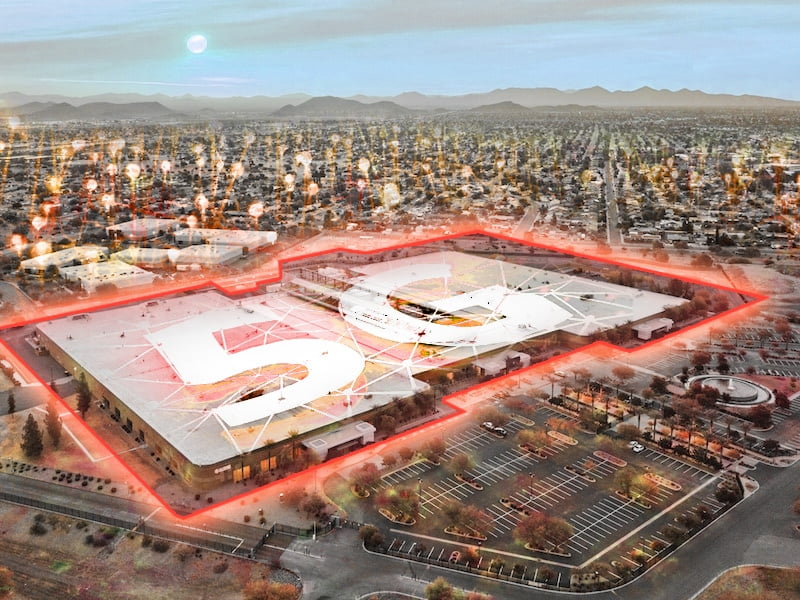Your cart is currently empty!

How 5G Could Triple Telecom Energy Usage & Increase Carbon Emissions
Last Updated on October 4, 2023

We’ve been talking about it for a while now: Worldwide deployment of the next generation 5G cellular network began in 2019, and will continue into 2020, with worldwide adoption slated for 2025.
For all the hyper-connected benefits 5G will bring, there will also be potential consequences. To learn more about 5G in general and the very real health dangers it poses, read about it on our 5G Guide.
Most are concerned about the ways higher-energy 5G frequencies can directly affect our bodies and health. Some are concerned about how 5G will affect bees, birds, and other plants and animals. Still others have brought up national and international security and privacy concerns.
But besides the people, the animals, and the crops, there is another very large and very relevant negative impact 5G will have on the Earth, though many are not aware of it. It could exponentially increase the amount of power we use every day, which could inexplicably raise carbon emissions (the very gas we are trying to neutralize) around the globe.
5G Versus 4G and the Previous Technology
5G is the next evolutionary step when it comes to our technological world. While it won’t replace 4G–it will simply build upon it–5G allows for a vast diversity of tasks that the 4G network cannot handle.
The Internet of Things will infiltrate our entire world thanks to 5G. Autonomous cars will now be possible. Soon everyone and everything will be able to be connected 24/7.
How does this advanced tech compare to the already seemingly archaic 4G network? Here is a comparative breakdown between the different generations:
- Latency (time delay): 10 millisecond → <1 millisecond
- Data Traffic: 7.2 exabytes/month → 50 exabytes/month (1 exabyte = 1 quintillion bytes)
- Peak Upload Rates: 1 Gb/s → 20 Gb/s
- Available spectrum: 3 GHz → 30 Ghz (with allocation up to 300 GHz)
Because of the capabilities of the new 5G networks to provide denser and faster streams of data, 5G will require more powerful transmitters and receivers, along with even greater processing capabilities.
Cell Phone & Phone Tower Power Usage
5G will require more connectivity, with higher bandwidth and faster speeds. This means getting the data to your phone will require more power from 5G devices and base stations transmitting the signal.
With 4G, U.S. telecoms use around 31 million megawatt-hours of electricity every year, which is enough to fully power 2.6 million U.S. homes.
While long-term processes for encoding 5G wireless signals are still being discussed, for now OFDM (Orthogonal Frequency-Division Multiplexing), a holdover from 4G, is the encoding route chosen. However, OFDM transmits data by chopping it up into portions and sending those portions on completely different frequencies, so they don’t interfere with each other (hence “Orthogonal”).
A negative of OFDM is that it may draw too much power in 5G devices and base stations.
This is because all the data portions traveling along different frequencies deliver energy constructively, meaning a data receiver or transmitter has to be able to take in or give out a lot of energy at once. This makes it less energy-efficient than other encoding schemes.
With 5G, this high energy usage will become a problem when more and more data needs to be transmitted to billions of mobile and wireless devices. A 5G base station is expected to consume roughly three times as much power as a 4G base station. And 5G towers will need to be placed every 750 feet, instead of every couple of miles, leading to a multiplication of power many times over.
Along with base stations, your cell phone and other devices will require more power to run. Your phone battery will get used up more quickly, and will either need to be plugged in more frequently or your phone will need a bigger battery, with either solution bringing up their own carbon footprint concerns.
“I don’t think the carriers really understood the impact on the mobile phone, and what it’s going to do to battery life,” says James Kimery, the director of marketing for RF and software-defined radio research at National Instruments Corp. “5G is going to come with a price, and that price is battery consumption.”
What Are Data Centers?
Once emails and texts are sent using higher-power transmitters and receivers, we may think they exist only in cyberspace, but in fact, all of that information is stored in a physical place.
Spoiler alert: the “cloud” isn’t in the sky—it’s in a giant computer tucked away in a warehouse somewhere in the world.
Simply put, data centers are a bunch of computers put together to process Internet traffic. Defined, data centers are “centralized locations where computing and networking equipment is concentrated for the purpose of collecting, storing, processing, distributing, or allowing access to large amounts of data.” And with all the data 5G will be processing, data centers will use more and more power.
How Data Centers Work
When you type out a tweet or post an Instagram picture, it is turned into electronic data. The data is converted into binary code, the language of computers, and is packed into packets up to 1,500 bytes. Each packet has a header and footer with descriptive information that a computer reads to understand what is in the packet, how it fits together with other packets, and the data’s origin and final destination.
Digital information packets are received at data centers, then the computers there figure out where that information needs to go, whether that means sending it on to continue its journey or storing it at the data center.
While a file may be made up of many different packets, each packet does not necessarily travel along the same path. The servers in data centers act as different roads for the information being sent over the Internet. One packet of information from the same file may be coming from a data center in London, England, and another one from Beijing, China. You never really know where your data is being processed.
The beauty of having such a large Internet infrastructure is that if one route becomes clogged and delayed, the information can be sent along a different path. This is one reason that 5G will require more data centers. The influx of information 5G will bring will in turn require more routes to prevent latency, or delay.
Now that we know that all the information on the Internet needs to go through a physical place, it’s possible to start to grasp just how important data centers actually are to society’s connected lifestyle. Our reliance on data centers will only increase as 5G connects our world even more.
Data Centers’ Environmental Toll
Data centers are massive feats of modern technology and engineering. However, being that data centers are essentially massive warehouses filled with wall-to-wall computer systems, they require A TON of electricity.
The servers themselves have to be powered, but additionally, the necessary air conditioners and cooling systems, lighting, uninterruptible power supply (UPS) systems and generators, fire suppression systems, and alarm systems all require power, too.
Data centers are one of the worst offenders when it comes to environmental impact. As technology continues to develop at an unheard-of pace, the harder data centers have to work to keep up with the increasing demand.
Already, data centers consume about 3% of globally generated power. And it’s estimated that in 2020, data centers will use approximately 73 billion kWh worth of electricity. For reference, according to World Bank’s most recent data from 2014, the global average household electric consumption was 3,132 kWh. The average American household used approximately 10,972 kWh in 2018.
Whenever people talk about environmental impact, the term carbon footprint usually pops up. So, what is a carbon footprint? It is the total amount of greenhouse gases—think carbon dioxide and methane—that are generated by one’s actions. The Earth’s atmosphere acts as a greenhouse, keeping in certain gases and thus warming the Earth’s surface. While it is a natural process, the added emissions from our industrialized life are altering the natural balance.
Things that contribute to your carbon footprint include travel habits, electricity usage, and food consumption. The average carbon footprint for an individual in the U.S. is 16 tons, an astonishing 4 times the global average of 4 tons. Click here to calculate your personal carbon footprint.
Data centers have one of the worst carbon footprints in the world. They emit and account for roughly 2% of all greenhouse gases. That level of emissions is equivalent to the airline industry. An article published at the Yale School of Forestry & Environmental Studies reported that if the global IT industry was a country, only China and the United States would have a worse impact on climate change.
The main issue for data centers’ carbon footprints is electricity usage. The cooling systems often require the most electricity to prevent the servers from overheating.
In an article written for the New York Times, Peter Gross, a data center designer, was quoted saying, “A single data center can take more power than a medium-sized town.” According to Yale’s article, the biggest data centers (which may cover more than a million square feet) can consume more power than a million people.
And this information comes from when data centers were only dealing with the 4G network. 5G is expected to have a much greater impact, as everything from wearable technology to cars will be powered by this next-generation network.
Northern Virginia: The Unexpected Data Center Headquarters
You can never tell where your data is being processed. But, there is a 7/10 chance it is being processed in the United States. Loudoun County, Virginia processes a staggering 70 percent of the world’s Internet traffic. That’s less than 150 miles from Green Bank, West Virginia, where all radio signals are banned.
Ashburn, Virginia, located in the heart of “Data Center Alley,” is situated upon the world’s densest intersection of fiber networks, making it the prime location to store and distribute data.
Why has Northern Virginia become a mecca for data centers? Way back in the 1960s, the U.S. government started to experiment in wide area fiber optic networking. Because of the proximity to Washington, D.C., the government chose Loudoun County for this technological development. Since then, the fiber connectivity, affordable and reliable power cost, and business-friendly environment encouraged its rapid expansion.
Northern Virginia has over 12 million square feet of commissioned data center space, which uses a staggering 800 megawatts of power. And these numbers will continue to grow as the IT industry grows with the introduction of 5G and beyond.
The Future: Can Data Centers Go Green?
While it doesn’t look like Telecom industries and data centers will refuse 5G on the basis of it taking too much energy, the future will require sustainable efficiency in the way we store and transmit data.
Microsoft and Apple have started the process already, and hopefully others follow suit.
In 2014, the Microsoft research team took on a revolutionary project: an underwater data center, called Project Natick. In 2018, after necessary research and testing was complete, they drowned a data center 100 feet below the surface of the North Sea by U.K.’s Orkney Islands.
While it may seem a bit absurd to send computers underwater, cooling the equipment in a data center requires an insane amount of energy, and using the naturally cool water, along with other renewable energy sources (wind, solar, and tidal), can make data centers more eco-friendly.
After being called out in the 2011 Greenpeace report “How Dirty is Your Data?” for its reliance on coal and having the lowest clean energy score, Apple began to work towards going green. In 2018, merely a few years after the exposé, Apple was able to transfer their entire global enterprise to 100 percent renewable energy. This includes all of their data centers.
As renewable energy becomes less expensive than traditional sources, more data centers might start taking sustainable steps. But will it be enough to combat the increased power usage with the rollout of 5G? With the increase in demand for new data centers thanks to 5G’s increase in Internet traffic, it might be a while before technology becomes carbon neutral, if ever.
Related Posts
None found



























